List of World Heritage Sites in Bosnia and Herzegovina facts for kids
The United Nations Educational, Scientific and Cultural Organization (UNESCO) helps protect important places around the world. These places are called World Heritage Sites. They can be special because of their history, culture, or natural beauty. UNESCO started this program in 1972.
Cultural sites include amazing buildings, sculptures, or old ruins. Natural sites are beautiful landscapes, unique rock formations, or places where rare animals and plants live. Bosnia and Herzegovina became part of this program on July 12, 1993, after the country of Yugoslavia split up.
As of 2021, Bosnia and Herzegovina has four World Heritage Sites. They also have 10 more places on a "tentative list." This means these places might become World Heritage Sites in the future.
The first site added was the Old Bridge Area of the Old City of Mostar in 2005. Next, the Mehmed Paša Sokolović Bridge in Višegrad was added in 2007. In 2016, the Stećci Medieval Tombstones Graveyards joined the list. This site is shared with Croatia, Serbia, and Montenegro. Bosnia and Herzegovina has 20 of the 28 listed Stećci sites, with the most famous one in Radimlja.
The newest site, added in 2021, is the Janj forest. This forest is part of a larger site called "Ancient and Primeval Beech Forests of the Carpathians and Other Regions of Europe," which is shared by 18 European countries. The Janj forest is a natural site, while the other three are cultural sites.
What are World Heritage Sites?
UNESCO chooses sites based on ten special rules or "criteria." Each site must meet at least one of these rules. Rules 1 to 6 are for cultural sites, and rules 7 to 10 are for natural sites. * This site is shared with other countries.
| Site Name | Picture | Location (City/Area) | Year Added | UNESCO Rules | What makes it special? |
|---|---|---|---|---|---|
| Old Bridge Area of the Old City of Mostar | 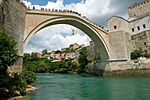 |
Mostar | 2005 | Rule 6 (Cultural) |
This site includes the famous Old Bridge and the area around it. The Ottoman bridge crosses the Neretva river. It was built in 1566/67 by order of Suleiman the Magnificent. Sadly, it was destroyed during the Bosnian War in 1993. It was rebuilt using old methods and materials, reopening in 2004. |
| Mehmed Paša Sokolović Bridge | 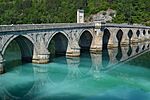 |
Višegrad | 2007 | Rules 2, 4 (Cultural) |
The Mehmed Paša Sokolović Bridge crosses the Drina river. It was finished in 1577 by a famous Ottoman architect named Mimar Sinan. The bridge is about 180 meters (590 feet) long and has 11 arches. It is also important because it represents a meeting point between Christianity and Islam. |
| Stećci Medieval Tombstones Graveyards* | 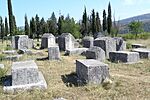 |
20 different places | 2016 | Rules 3, 6 (Cultural) |
Stećci (pronounced stetch-tsee) are large, ancient tombstones from the Middle Ages. You can find them in Bosnia and Herzegovina, and parts of Croatia, Serbia, and Montenegro. They first appeared in the 1100s and were most popular in the 1300s and 1400s. There are 20 Stećci sites in Bosnia and Herzegovina, mostly in the southeast. The biggest group is in Radimlja, near Stolac. |
| Ancient and Primeval Beech Forests of the Carpathians and Other Regions of Europe* |  |
Šipovo | 2021 | Rule 9 (Natural) | This site protects untouched temperate forests. These forests show how European beech trees spread across Europe after the last Ice Age. The site started in 2007 with forests in Slovakia and Ukraine. Over time, it grew to include forests in 18 countries, including the Janj forest in Bosnia and Herzegovina, which was added in 2021. |
What places are on the Tentative List?
Countries can suggest new sites for the World Heritage List by putting them on a "tentative list" first. A site must be on this list before it can be officially nominated. As of 2021, Bosnia and Herzegovina has ten sites on its tentative list.
| Site Name | Picture | Location (City/Area) | Year Added | UNESCO Rules | What makes it special? |
|---|---|---|---|---|---|
| Sarajevo – a unique symbol of different cultures |  |
Sarajevo | 1997 | Rule 5 (Cultural) |
Sarajevo is the capital city of Bosnia and Herzegovina. It has a long and interesting history of many different religions and cultures living together. |
| Vjetrenica cave | 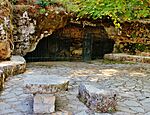 |
Ravno | 2004 | Rules 7, 10 (Natural) |
Vjetrenica means "the wind cave." It is the biggest cave in Bosnia and Herzegovina. In warmer months, cool air blows from its entrance. It's a very important place for many different kinds of plants and animals. Scientists have also found fossils of ancient meat-eating animals here. |
| The natural and architectural beauty of Jajce | 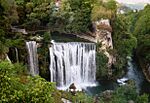 |
Jajce | 2006 | Rules 2, 3, 4, 5, 6, 7 (Mixed) |
The city of Jajce is located where the Pliva and Vrbas rivers meet. It was first built in the Middle Ages and got its final look during the Ottoman period. |
| The historic town of Počitelj | 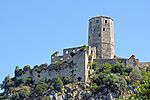 |
Čapljina | 2007 | Rules 2, 3, 4, 5, 6 (Cultural) |
The town of Počitelj is one of the few places in Bosnia and Herzegovina that still looks much like it did in medieval times and during the Ottoman period. |
| The natural and architectural beauty of Blagaj | 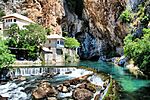 |
Mostar | 2007 | Rules 2, 3, 4, 5, 6, 7 (Mixed) |
The town of Blagaj is located at the spring of the Buna river. It has several examples of Ottoman buildings, like the Blagaj Tekke. |
| The natural and architectural beauty of Blidinje | 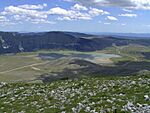 |
Jablanica, Posušje, Tomislavgrad | 2007 | Rules 1, 3, 4, 5, 6, 7, 8, 9 (Mixed) |
The Blidinje Nature Park shows how mountains like the Dinarides were formed. It also shows how plants and animals developed after the Ice Age. The area has many unique plants and some Stećak tombstones. |
| The natural and architectural beauty of Stolac | 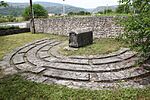 |
Stolac | 2007 | Rules 2, 3, 4, 5, 6, 7 (Mixed) |
The old part of Stolac is a great example of a place with a rich mix of history and nature. It has remains from ancient times, the Illyrian and Roman periods, the Middle Ages, and the Ottoman, Austro-Hungarian, and Yugoslav eras. |
| Strict Nature Reserve – Primeval forest "Perućica" |  |
Foča | 2017 | Rules 7, 9, 10 (Natural) |
The ancient forest of Perućica is a very important place for many different kinds of plants and animals. It is home to brown bears, wolfes, and lynxes, as well as many birds, reptiles, and amphibians. A mountain stream in the forest forms the 75-meter (246-foot) high Skakavac Waterfall. |
| Jewish Cemetery in Sarajevo | 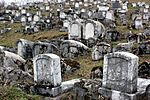 |
Sarajevo | 2018 | Rules 2, 3, 4, 6 (Cultural) |
This burial ground is on a hillside and covers a large area. It has over 3,850 tombstones and memorials for victims of World War II. There's also a special place for old books. The cemetery was closed for burials in 1966. |
| Complex of travertine waterfalls in Martin Brod - Una National Park | 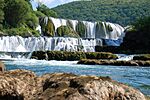 |
Bihać | 2019 | Rules 7, 9 (Natural) |
The upper part of the Una river has many beautiful waterfalls and special rock formations called travertine. It is also an important place for many different types of plants and animals. |
See also
 In Spanish: Anexo:Patrimonio de la Humanidad en Bosnia y Herzegovina para niños
In Spanish: Anexo:Patrimonio de la Humanidad en Bosnia y Herzegovina para niños
- List of Intangible Cultural Heritage elements in Bosnia and Herzegovina
- List of National Monuments of Bosnia and Herzegovina
- List of protected areas of Bosnia and Herzegovina

